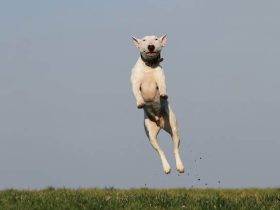Dog body language understanding and analyzing dog posture are cornerstones of every relationship, between you and your furry companion. Dogs possess an intricate system of nonverbal cues that reveal their thoughts, emotions, and intentions. Interpreting dog emotions and understanding your dog’s body language is essential for building a deeper connection and ensuring their well-being. In this comprehensive guide, we’ll explore seven distinct ways your dog communicates with you through body language, shedding light on their feelings and needs.
Did you know these are the 7 ways your dog talks
There are different dog communication methods which your little pet friend exhibits. but failure to pay attention to them, you will be missing a lot and may result to less bonding something you do not want. That is why understanding pet body language is very crucial. Nonverbal communication with dogs can be seen from the following ways
1. Tail Wagging dog body language – The Universal Greeting
Have you wondered what is the meaning of tail wagging in dogs, you are not alone. however, the tail is a dog’s emotional flag, expressing a myriad of sentiments. While the classic image of a wagging tail conveys Signs of dog happiness, the speed, height, and direction of the wag also matter. A fast, high wag typically signifies excitement, while a slow, low wag may hint at uncertainty or submission. A stiff tail held high can indicate dominance or alertness, while a tucked tail signals fear or anxiety.
2. Ears dog body language – Windows to the Soul
Your dog’s ears are like antennae, attuned to their environment and emotions. Erect ears signify attentiveness or curiosity, while flattened ears against the head indicate fear or submission. A slight tilt of the head coupled with raised ears can express curiosity or confusion. By observing their ears’ position and movement, you can gain valuable insights into your dog’s emotional state.
3. Dog Eyes body language – Mirrors of Emotion
Paying attention to your dog eye expressions is vital in understanding canine communication. Dogs’ eyes can reveal a wealth of emotions. A soft, relaxed gaze communicates comfort and contentment, while dilated pupils may indicate excitement or heightened alertness. Intense staring can convey focus or aggression, depending on the overall body posture. Blinking slowly can be a sign of trust and submission, making eye contact an essential element of your interaction.
4. Barking – Vocal Expressions
Barking is a primary vocalization used by dogs to communicate. The tone, volume, and frequency of barks carry different meanings. A rapid, high-pitched bark often reflects excitement or playfulness, while a deep, continuous bark may signify warning or alertness. Recognizing the context in which your dog barks and understanding their vocal patterns can help you interpret their messages accurately.
5. Body Posture – Silent Signals
The way your dog positions their body provides valuable clues about their emotions. A dog body language of standing tall with a confident posture is likely feeling secure, while cowering or slinking indicates fear. Playfulness is often expressed through a play bow, where the front half of the body is lowered while the tail wags eagerly. Additionally, a rigid stance or raised hackles can signal aggression or defensiveness.
6. Licking and Nuzzling – Affectionate Gestures
Dogs use their mouths not only for eating but also for communicating affection. Licking is a sign of trust and social bonding, akin to a friendly handshake. Nuzzling against you shows closeness and a desire for interaction. However, excessive licking or nuzzling can also be an indicator of anxiety, so it’s essential to consider the context and your dog’s overall behavior.
7. Rolling Over – Vulnerability and Trust
When your dog rolls over to expose their belly, it’s a demonstration of vulnerability and trust. This gesture is an invitation for belly rubs and affection. While it’s often associated with submission and friendliness, it’s crucial to differentiate between a relaxed, playful roll and a tense, defensive one. Being attuned to their overall demeanor helps you accurately interpret this gesture.
Conclusion
Deciphering your dog body language is an art that deepens your connection and enriches your relationship. Dog behavior cues are important part of their communications as beings. By keenly observing their tail wags, ears, eyes, barks, posture, gestures, and overall demeanor, you can decode their thoughts and feelings. This enhanced understanding not only fosters effective communication but also ensures their well-being by addressing their needs and emotions. In this journey of mutual understanding, you become attuned to the silent language that bridges the gap between humans and their beloved canine companions.





Leave a Reply